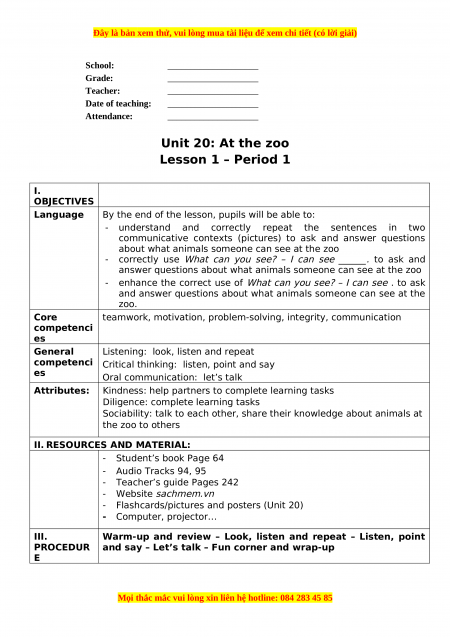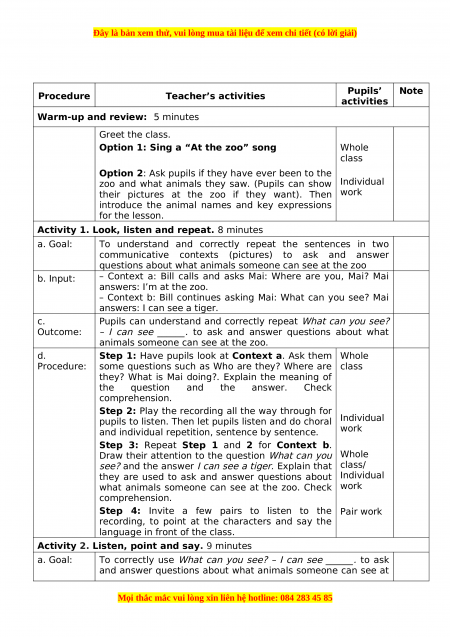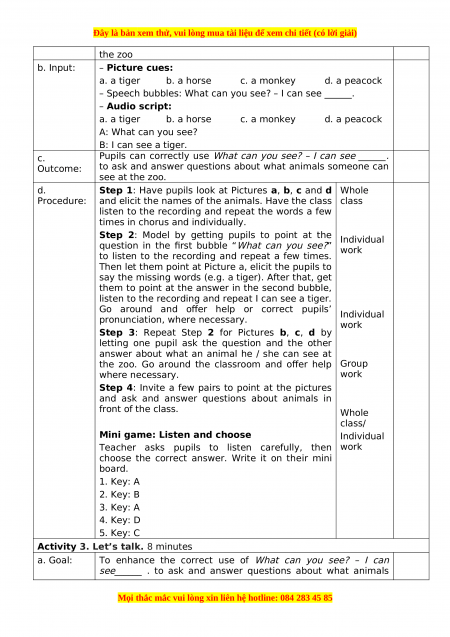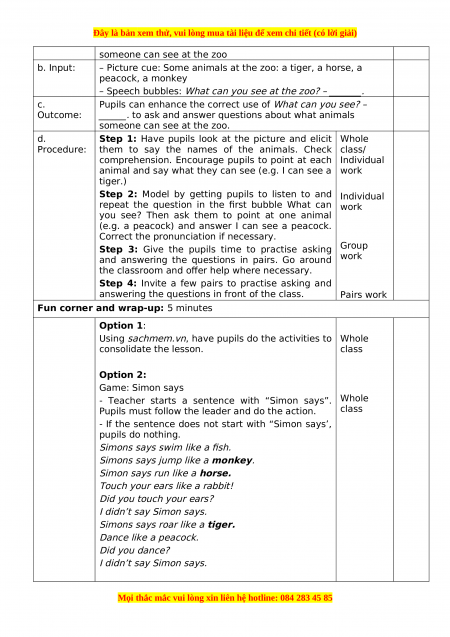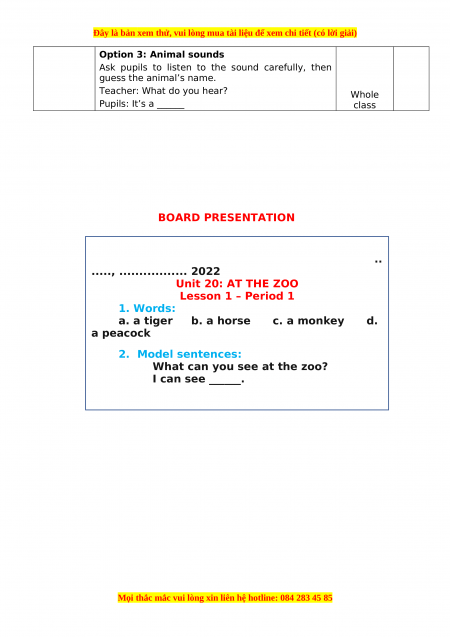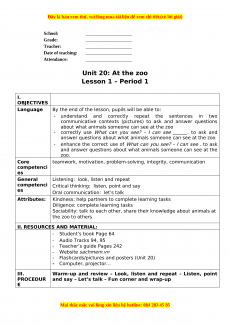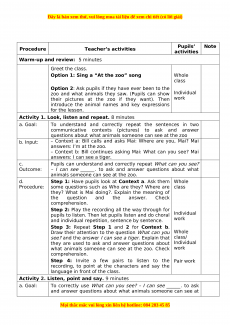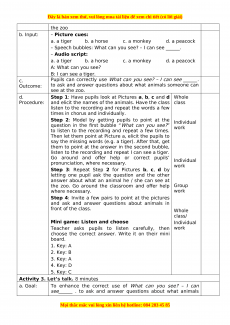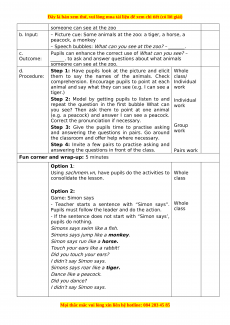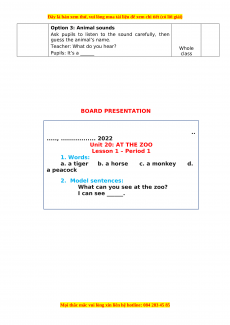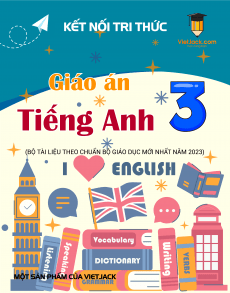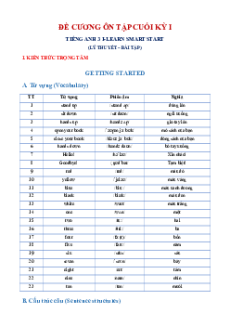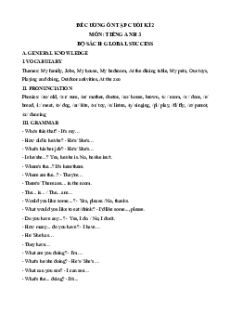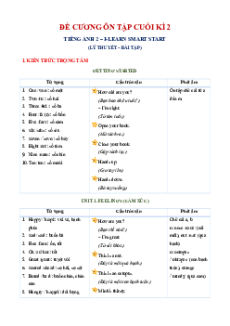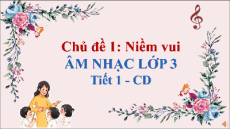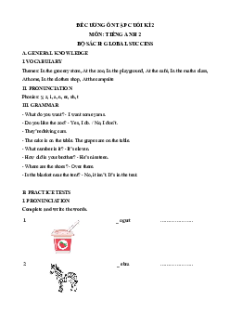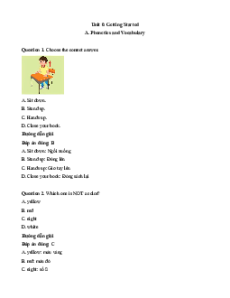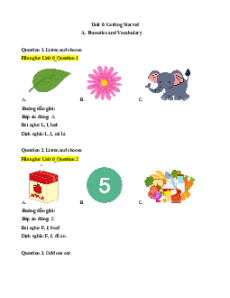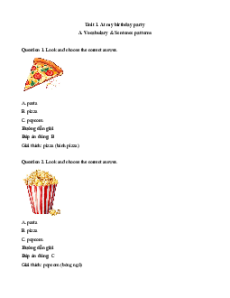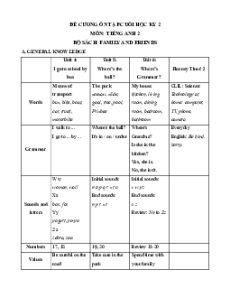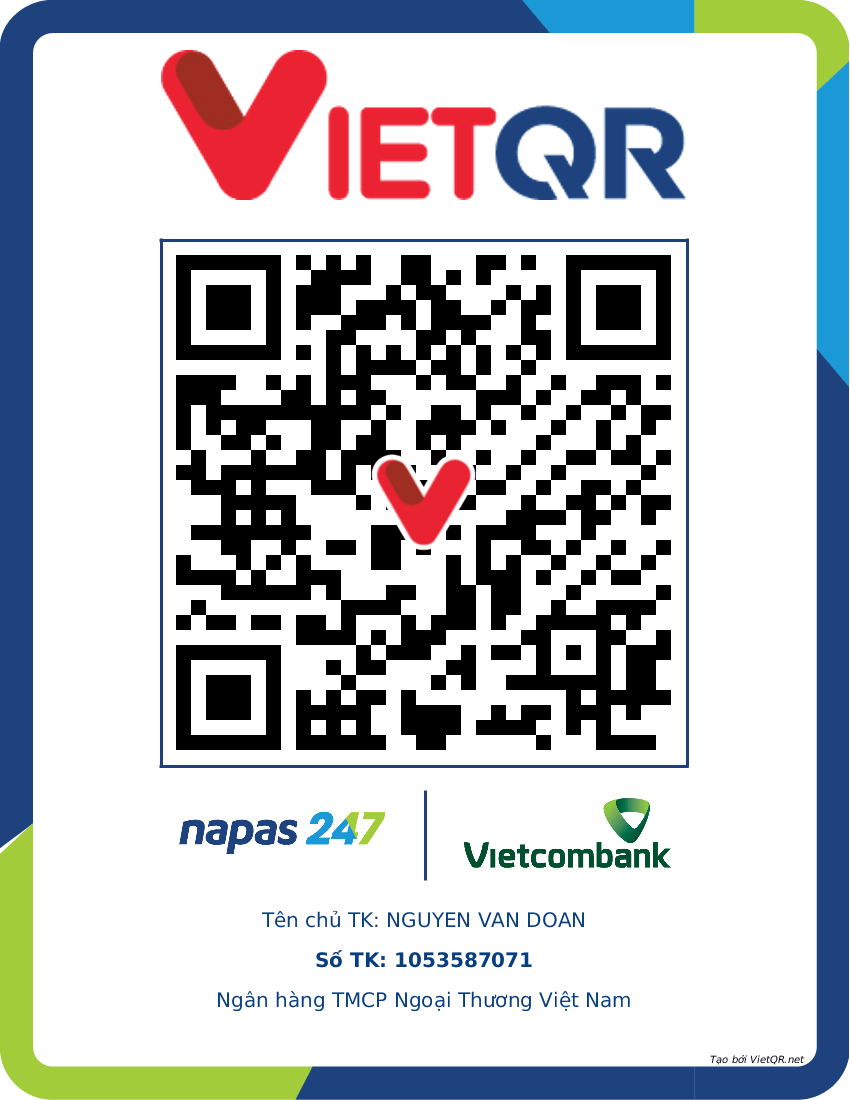School: ____________________ Grade: ____________________ Teacher: ____________________ Date of teaching: ____________________ Attendance: ____________________ Unit 20: At the zoo Lesson 1 – Period 1 I. OBJECTIVES Language
By the end of the lesson, pupils will be able to:
- understand and correctly repeat the sentences in two
communicative contexts (pictures) to ask and answer questions
about what animals someone can see at the zoo
- correctly use What can you see? – I can see ______. to ask and
answer questions about what animals someone can see at the zoo
- enhance the correct use of What can you see? – I can see . to ask
and answer questions about what animals someone can see at the zoo. Core
teamwork, motivation, problem-solving, integrity, communication competenci es General
Listening: look, listen and repeat
competenci Critical thinking: listen, point and say es
Oral communication: let’s talk Attributes:
Kindness: help partners to complete learning tasks
Diligence: complete learning tasks
Sociability: talk to each other, share their knowledge about animals at the zoo to others
II. RESOURCES AND MATERIAL: - Student’s book Page 64 - Audio Tracks 94, 95 - Teacher’s guide Pages 242 - Website sachmem.vn
- Flashcards/pictures and posters (Unit 20)
- Computer, projector… III.
Warm-up and review – Look, listen and repeat – Listen, point PROCEDUR
and say – Let’s talk – Fun corner and wrap-up E
Pupils’ Note Procedure Teacher’s activities activities
Warm-up and review: 5 minutes Greet the class.
Option 1: Sing a “At the zoo” song Whole class
Option 2: Ask pupils if they have ever been to the
zoo and what animals they saw. (Pupils can show Individual
their pictures at the zoo if they want). Then work
introduce the animal names and key expressions for the lesson.
Activity 1. Look, listen and repeat. 8 minutes a. Goal:
To understand and correctly repeat the sentences in two
communicative contexts (pictures) to ask and answer
questions about what animals someone can see at the zoo b. Input:
– Context a: Bill calls and asks Mai: Where are you, Mai? Mai answers: I’m at the zoo.
– Context b: Bill continues asking Mai: What can you see? Mai answers: I can see a tiger. c.
Pupils can understand and correctly repeat What can you see? Outcome:
– I can see ______. to ask and answer questions about what
animals someone can see at the zoo. d.
Step 1: Have pupils look at Context a. Ask them Whole Procedure:
some questions such as Who are they? Where are class
they? What is Mai doing?. Explain the meaning of
the question and the answer. Check comprehension.
Step 2: Play the recording all the way through for
pupils to listen. Then let pupils listen and do choral Individual
and individual repetition, sentence by sentence. work
Step 3: Repeat Step 1 and 2 for Context b.
Draw their attention to the question What can you Whole
see? and the answer I can see a tiger. Explain that class/
they are used to ask and answer questions about Individual
what animals someone can see at the zoo. Check work comprehension.
Step 4: Invite a few pairs to listen to the Pair work
recording, to point at the characters and say the
language in front of the class.
Activity 2. Listen, point and say. 9 minutes a. Goal:
To correctly use What can you see? – I can see ______. to ask
and answer questions about what animals someone can see at
the zoo b. Input: – Picture cues:
a. a tiger b. a horse c. a monkey d. a peacock
– Speech bubbles: What can you see? – I can see ______. – Audio script:
a. a tiger b. a horse c. a monkey d. a peacock A: What can you see? B: I can see a tiger. c.
Pupils can correctly use What can you see? – I can see ______. Outcome:
to ask and answer questions about what animals someone can see at the zoo. d.
Step 1: Have pupils look at Pictures a, b, c and d Whole Procedure:
and elicit the names of the animals. Have the class class
listen to the recording and repeat the words a few
times in chorus and individually.
Step 2: Model by getting pupils to point at the Individual
question in the first bubble “What can you see?” work
to listen to the recording and repeat a few times.
Then let them point at Picture a, elicit the pupils to
say the missing words (e.g. a tiger). After that, get
them to point at the answer in the second bubble,
listen to the recording and repeat I can see a tiger.
Go around and offer help or correct pupils’ Individual
pronunciation, where necessary. work
Step 3: Repeat Step 2 for Pictures b, c, d by
letting one pupil ask the question and the other
answer about what an animal he / she can see at
the zoo. Go around the classroom and offer help Group where necessary. work
Step 4: Invite a few pairs to point at the pictures
and ask and answer questions about animals in front of the class. Whole class/
Mini game: Listen and choose Individual
Teacher asks pupils to listen carefully, then work
choose the correct answer. Write it on their mini board. 1. Key: A 2. Key: B 3. Key: A 4. Key: D 5. Key: C
Activity 3. Let’s talk. 8 minutes a. Goal:
To enhance the correct use of What can you see? – I can
see______ . to ask and answer questions about what animals
someone can see at the zoo b. Input:
– Picture cue: Some animals at the zoo: a tiger, a horse, a peacock, a monkey
– Speech bubbles: What can you see at the zoo? – _______. c.
Pupils can enhance the correct use of What can you see? – Outcome:
______. to ask and answer questions about what animals someone can see at the zoo. d.
Step 1: Have pupils look at the picture and elicit Whole Procedure:
them to say the names of the animals. Check class/
comprehension. Encourage pupils to point at each Individual
animal and say what they can see (e.g. I can see a work tiger.)
Step 2: Model by getting pupils to listen to and Individual
repeat the question in the first bubble What can work
you see? Then ask them to point at one animal
(e.g. a peacock) and answer I can see a peacock.
Correct the pronunciation if necessary.
Step 3: Give the pupils time to practise asking Group
and answering the questions in pairs. Go around work
the classroom and offer help where necessary.
Step 4: Invite a few pairs to practise asking and
answering the questions in front of the class. Pairs work
Fun corner and wrap-up: 5 minutes Option 1:
Using sachmem.vn, have pupils do the activities to Whole consolidate the lesson. class Option 2: Game: Simon says
- Teacher starts a sentence with “Simon says”. Whole
Pupils must follow the leader and do the action. class
- If the sentence does not start with “Simon says’, pupils do nothing. Simons says swim like a fish.
Simons says jump like a monkey.
Simon says run like a horse.
Touch your ears like a rabbit! Did you touch your ears? I didn’t say Simon says.
Simons says roar like a tiger. Dance like a peacock. Did you dance? I didn’t say Simon says.
Giáo án Unit 20 Tiếng anh 3 global success
CÁCH MUA:
- B1: Gửi phí vào TK:
1133836868- CT TNHH DAU TU VA DV GD VIETJACK - Ngân hàng MB (QR) - B2: Nhắn tin tới Zalo VietJack Official ( nhấn vào đây ) để xác nhận thanh toán và tải tài liệu - giáo án
Liên hệ ngay Hotline hỗ trợ: 084 283 45 85
Bộ giáo án Tiếng anh 3 Global success được cập nhật liên tục trong gói này từ nay đến hết tháng 6/2023.
Để tải tài liệu gốc về máy bạn click vào nút Tải Xuống ở trên!
Thuộc bộ (mua theo bộ để tiết kiệm hơn):
-
Bộ giáo án Tiếng anh 3 Global success năm 2023 mới, chuẩn nhất được thiết kế theo phong cách hiện đại, đẹp mắt, trình bày chi tiết cho từng bài học và bám sát chương trình sách giáo khoa Tiếng anh 3 Global success.
-
Mua trọn bộ sẽ tiết kiệm hơn tải lẻ 50%.
Đánh giá
4.6 / 5(2015 )Trọng Bình
Giúp ích cho tôi rất nhiều
Duy Trần
Rất thích tài liệu bên VJ soạn (bám sát chương trình dạy)
TÀI LIỆU BỘ BÁN CHẠY MÔN Tiếng Anh
Xem thêmTÀI LIỆU BỘ BÁN CHẠY Lớp 3
Xem thêmTài liệu bộ mới nhất





